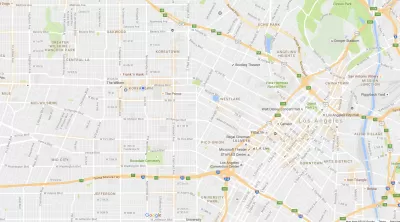Google's new maps redesign calls out areas of interest, but is "interesting" just a euphemism for rich?

"Interesting" is one of those garbage words that doesn't mean much; in different contexts, it's used to mean good, bad, weird, and (once in a great while) worthy of interest. So it was "interesting" when Google launched a new feature highlighting "areas of interest."
The deeply subjective notion of what is interesting seemed problematic (another deeply flawed word) to Joe Cortright. He cites a CityLab piece by Laura Bliss that compared the highlights in the more commercial Westlake neighborhood of Los Angeles to the richer but more residential Sawtelle, finding that Sawtelle seemed to be generously marked as "of interest" even on blocks where the only interesting things would seem to be people's houses.
Still, the word is slippery and Cortright's article in City Observatory goes on to say, "it’s a fair point to suggest that not everyone will find the same set of destinations “interesting,” and it’s likely, given capitalism, demographics and math, that any algorithm-based means of identifying interesting areas will tend to select places that appeal to the masses." Cortright suggests the solution to the "interesting” problem will come from more iteration on the concept of mapping points-of-interest, and he predicts that is likely to happen. "The more data (including everything geolocated on the web, including Google maps and listings, tweets, user reviews, and traffic data) are widely available to end users, and the more different the people who are crafting their own maps, the better we may be able to create images that reflect the diversity of interests of map users."
FULL STORY: The most interesting neighborhood in the world

Alabama: Trump Terminates Settlements for Black Communities Harmed By Raw Sewage
Trump deemed the landmark civil rights agreement “illegal DEI and environmental justice policy.”

Planetizen Federal Action Tracker
A weekly monitor of how Trump’s orders and actions are impacting planners and planning in America.

The 120 Year Old Tiny Home Villages That Sheltered San Francisco’s Earthquake Refugees
More than a century ago, San Francisco mobilized to house thousands of residents displaced by the 1906 earthquake. Could their strategy offer a model for the present?

In Both Crashes and Crime, Public Transportation is Far Safer than Driving
Contrary to popular assumptions, public transportation has far lower crash and crime rates than automobile travel. For safer communities, improve and encourage transit travel.

Report: Zoning Reforms Should Complement Nashville’s Ambitious Transit Plan
Without reform, restrictive zoning codes will limit the impact of the city’s planned transit expansion and could exclude some of the residents who depend on transit the most.

Judge Orders Release of Frozen IRA, IIJA Funding
The decision is a victory for environmental groups who charged that freezing funds for critical infrastructure and disaster response programs caused “real and irreparable harm” to communities.
Urban Design for Planners 1: Software Tools
This six-course series explores essential urban design concepts using open source software and equips planners with the tools they need to participate fully in the urban design process.
Planning for Universal Design
Learn the tools for implementing Universal Design in planning regulations.
Clanton & Associates, Inc.
Jessamine County Fiscal Court
Institute for Housing and Urban Development Studies (IHS)
City of Grandview
Harvard GSD Executive Education
Toledo-Lucas County Plan Commissions
Salt Lake City
NYU Wagner Graduate School of Public Service





























